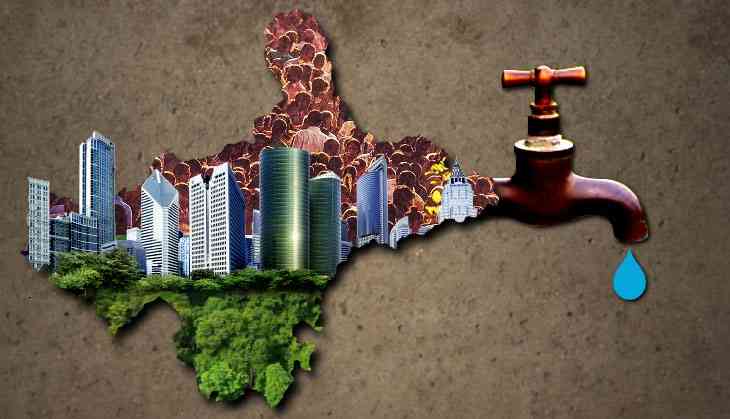How govt's sluggish approach has thrown Shimla into an unprecedented water crisis

Shimla –-The Queen of Hills and the British Summer Capital – is reeling under an unprecedented water crisis. It is experiencing its Cape Town moment. The extent of this crisis can be gauged from the pictures that were splashed in the regional dailies on Monday showing that the people stood queued even on the Mall Road, that symbol of prestige, popularity and elitism, with their pots and pans for the supply from a tanker. Parts of the town did not receive water supply for a week in succession.
The question is what and who is responsible for things coming to such a pass. The answer is human greed and bankruptcy of successive governments and bureaucrats when it came to coming up with ideas and solutions for the emerging crisis. After all, this crisis has not developed over night. An indication of the state of affairs can be gauged from the fact that the Mayor Kusum Sadret of the Bharatiya Janata Party (BJP) who is the first citizen of the city has done a Nero. She is away to China at a time when tempers are on the boil over the water crisis.
“It was bound to happen. Nobody cared to address the issue of the unplanned development that has taken place over the years. Nobody talks about the carrying capacity of the towns in the hills. One just has to understand the natural distribution in the hilsl where houses have always been located at a distance from one another. Here the water as well as land resources are scarce,” points out activist Manshi Asher of Himdhara – an environment research and collective that has been investigating and evaluating the environmental changes in the state of Himachal Pradesh.
Come to think of it, the Shimla town that had a population of around 14,000 in 1901 and today it is close to two lakh. Add to this the weekend rush of around 30,000 tourists from the neighbouring states apart from the tourists flocking from other places as well during the summer holidays. Reports say that Shimla was one of India's first cities to get piped water way back in 1875 having a water supply scheme to supply 4.54 million litres per day (MLD). Things have surely gone downhill ever since.
Locals point out that the unauthorized illegal construction that has taken place right under the nose of the administration and the government is he main culprit.
“The springs from which we used to quench our thirst just thirty years back today have hotels built on them. An abnormally high number of houses have been allowed to turn into hotels. Earlier a large number of hoteliers used to quietly manage their supplies but this time even they are making a lo of noise,” recalls a former Shimla resident presently residing in Chandigarh.
To make matters worse reinforced cement concrete construction has been allowed all over the place that has prevented recharge of natural water resources. The governments have also allowed the pollution of the catchment areas.
Then of course is the question of inequity in distribution of water. On one side there are thousands waiting for a meager supply through taps and tankers and on the other is the allegation of daily supply going to the VVIP area. Then there are hotels offering you five star facilities like 24-hour water supply.
“There is no effort to link water supply to forests which are deeply interconnected. The soil moisture content is going down because of various factors like fores fires and the climate change,” points out Asher.
But there seems to be no long term plan and foresight to deal with these issues. Instead the focus is on dealing with the immediate crisis and superficial solution. The government needs to come up with forest management interventions along with efforts to check illegal construction. The tourist inflow will also have to be curtailed and managed in a better manner. Nature has always provide enough for human need but it simply cannot prove for the unbridled greed.
In fact, there is a desperate need to carry out an audit of the tree cover, particularly with regards to the afforestation that has been done in lieu of the trees that have been chopped for the so called development. The audit must answer how many trees were planted, of what species and what has been their survival rate. If the government is reluctant to do so, the courts must intervene on this count.
“It is a simple case of sluggish government and administration. They have failed to curtail the mismanagement. The least that could have been done is that the 'Bavdis' could have been treated. We were able to get three of them treated under a project from the European Union and here as been no hue and cry from the residents of these areas,” underlined former deputy mayor Tikender Panwar of the CPI(M).
It is being pointed that the memorandum of understanding that had been signed by the Shimla Municipal Corporation and the World Bank three years back for lifting water from the Kol Dam should have been executed. The Rs 1200 crore project still remains at the dialogue stage.
The government has been trying to save face on the issue of water crisis with Chief Minister Jai Ram Thakur directing the officials for ensuring better water supply in Shimla, so that every household could get sufficient supply of water. He has also directed to check the leakages in water pipelines while asking the Shimla Municipal Commissioner Rohit Jamwal to provide water through tankers, especially in water scarce areas of the town on priority bases. He has also promised additional water tankers for the purpose.
On the macro level the state government has proposed a Rs. 4751 crore project for funding to the union government for rain water harvesting in the state. After a review meeting of irrigation and public health department three days back Thakur said that the government is contemplating to check the water wastage by building rain water harvesting structures and the water so conserved can be used for irrigation and other purposes during the days of scarcity.
He further disclosed that the government has also sent another proposal of Rs. 798 crore for central funding for remodeling and augmentation of 1421 water supply schemes in the state.
These initiatives are fine but what is more important is immediate steps to check rampant illegal construction and ensuring the recharge of natural sources of water. Does the government have the political will to do so?


